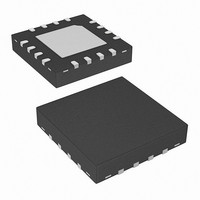ISL9205IRZ-T Intersil, ISL9205IRZ-T Datasheet - Page 10

ISL9205IRZ-T
Manufacturer Part Number
ISL9205IRZ-T
Description
IC CHRGR LI-ION SGL 4.2V 16-QFN
Manufacturer
Intersil
Datasheet
1.ISL9205CIRZ.pdf
(14 pages)
Specifications of ISL9205IRZ-T
Function
Charge Management
Battery Type
Lithium-Ion (Li-Ion), Lithium-Polymer (Li-Pol)
Voltage - Supply
4.25 V ~ 6.5 V
Operating Temperature
-40°C ~ 85°C
Mounting Type
Surface Mount
Package / Case
16-VQFN Exposed Pad, 16-HVQFN, 16-SQFN, 16-DHVQFN
Lead Free Status / RoHS Status
Lead free / RoHS Compliant
During the constant voltage phase, the charge current
reduces gradually as the cell voltage rises.
End-of-Charge and Recharge
As the charge current reaches the EOC (end-of-charge)
current threshold during the constant voltage phase, the
STATUS pin open-drain FET is turned off to indicate an EOC
condition. The EOC current is programmable for the
ISL9205 by connecting a resistor from the IMIN pin to GND.
For others, the EOC current is fixed at 10% of the
programmed constant charge current. When the STATUS
pin indicates the EOC condition, the charger will continue to
charge until the EN pin is pulled to logic LOW or the input
power has been removed. After EOC is reached, recharge
will occur when the battery voltage falls to 150mV below the
constant voltage value. The STATUS open-drain FET is
turned on when a recharge condition is met. An internal
delay is implemented at the STATUS pin for both EOC and
recharge conditions to prevent nuisance trips due to noise
and fast load current transitions. The delay time is
approximately one clock cycle (varies between 0.5 and 1.5
clock) of the internal oscillator, which is programmed by the
timer capacitor. The typical charge waveforms in Figure 13
show the complete cycle operation.
Temperature Monitoring and Thermal Foldback
In the event where the die temperature reaches the thermal
foldback threshold (+110°C typical), the charge current is
reduced accordingly to prevent further temperature rise. In
the ISL9205 and ISL9205D versions, there is an external
temperature monitoring function. A negative temperature
coefficient (NTC) thermistor can be connected between the
TEMP pin and GND to monitor the battery temperature or
ambient temperature. The hysteresis comparators internal to
the ISL9205 provide a valid temperature window centered at
the voltage of the TEMP pin, which is programmed by the
NTC and the pull-up resistor connected to the pin. When the
measured temperature is outside this window, the charger is
paused (both the charger and the timer are stopped) and a
fault indication is issued. If the thermistor is attached to the
10%I
CHG
4.2V
2.8V
I
REF
FIGURE 13. TYPICAL CHARGE CYCLE WITH TIMEOUT
REF
Trickle
CC
10
Indication
STATUS
Current
Charge
I
MIN
Voltage
Charge
CV
TIME
V
REC
ISL9205
battery, the TEMP function can be used to discover a battery
removal condition when the TEMP pin voltage is much
higher than the reference threshold.
POR
The power-on reset (POR) function monitors the supply
voltage. The POR has a rising edge threshold of 3.6V typical
and 2.5V typical for falling edge. The charger is expected to
operate when the input voltage is above the POR threshold.
After POR the charger will continue to operate for supply
voltage down to 2.5V typical. It is also required that the
supply voltage be higher than the VBAT pin voltage by a
typical 80mV for the charger to function.
Oscillator, TIMEOUT, and Charge Cycle
The ISL9205 incorporates with an oscillation circuit using an
external timing capacitor connected to the TIME pin. The
oscillator sets the limit for the maximum charge time during
the trickle mode and the fast mode (CC and CV). The
maximum charge time (TIMEOUT) for the fast mode is set
by:
TIMEOUT = 2
where the t
programmable t
for the trickle charge is 1/8 of the fast mode time limit. In the
ISL9205, the time-out function can be disabled by pulling the
TOEN pin to logic LOW. When TIMEOUT is disabled, the
charger will never be turned off in constant current and
constant voltage modes. For the ISL9205B and the
ISL9105D, the timeout function is always enforced. For the
ISL9105A, there is not timeout function.
A charge cycle is the time interval between the time when
the charger is enabled to the moment it is disabled. If the
battery voltage is lower than the trickle charge threshold at
the time the charger is enabled, the charger enters the trickle
mode and the timer is reset and its limit is set to 1/8 of
TIMEOUT. If the timeout function is enabled, the charger will
stop and indicate a TIMEOUT fault if the charge time is
longer than the limit. If the trickle mode completes
successfully before the time limit, the charger moves to CC
mode and the timer is reset and the time limit is set to
TIMEOUT. The charger needs to reach the EOC conditions
before the TIMEOUT interval elapsed, otherwise, a
TIMEOUT fault will be issued. The charger indicates the
EOC with the STATUS pin but does not terminate charging.
Disabling TIMEOUT with TOEN
In the ISL9205, the time-out function in fast charge state
(CC/CV) can be disabled by pulling the TOEN pin to logic
LOW. The timeout function for the trickle charge mode can
not be disabled. Note that in the ISL9205A, there is no
timeout function for both the trickle and the CC/CV intervals
whereas in the ISL9205 with TOEN set pulled to LOW, there
is no timeout for the CC/CV interval but the timeout function
for the trickle interval is still enforced.
OSC
22
OSC
t
is the oscillator period. The minimum
OSC
is 20μS (C
TIME
= 100pF). The time limit
July 28, 2010
FN9252.2











